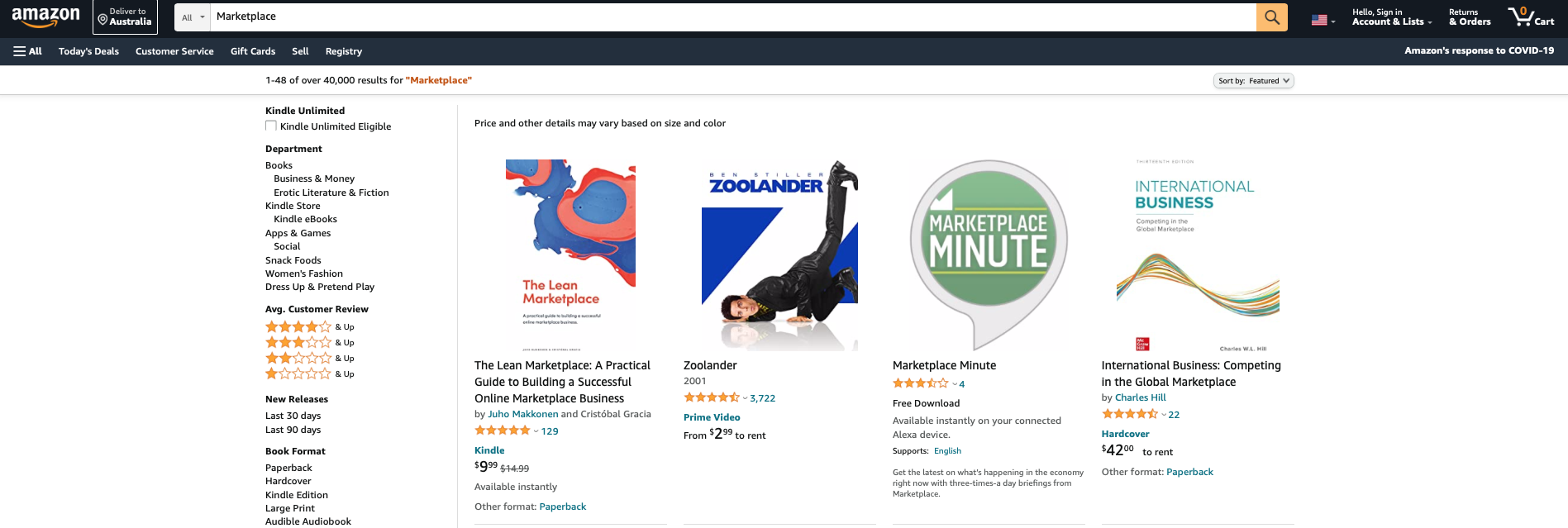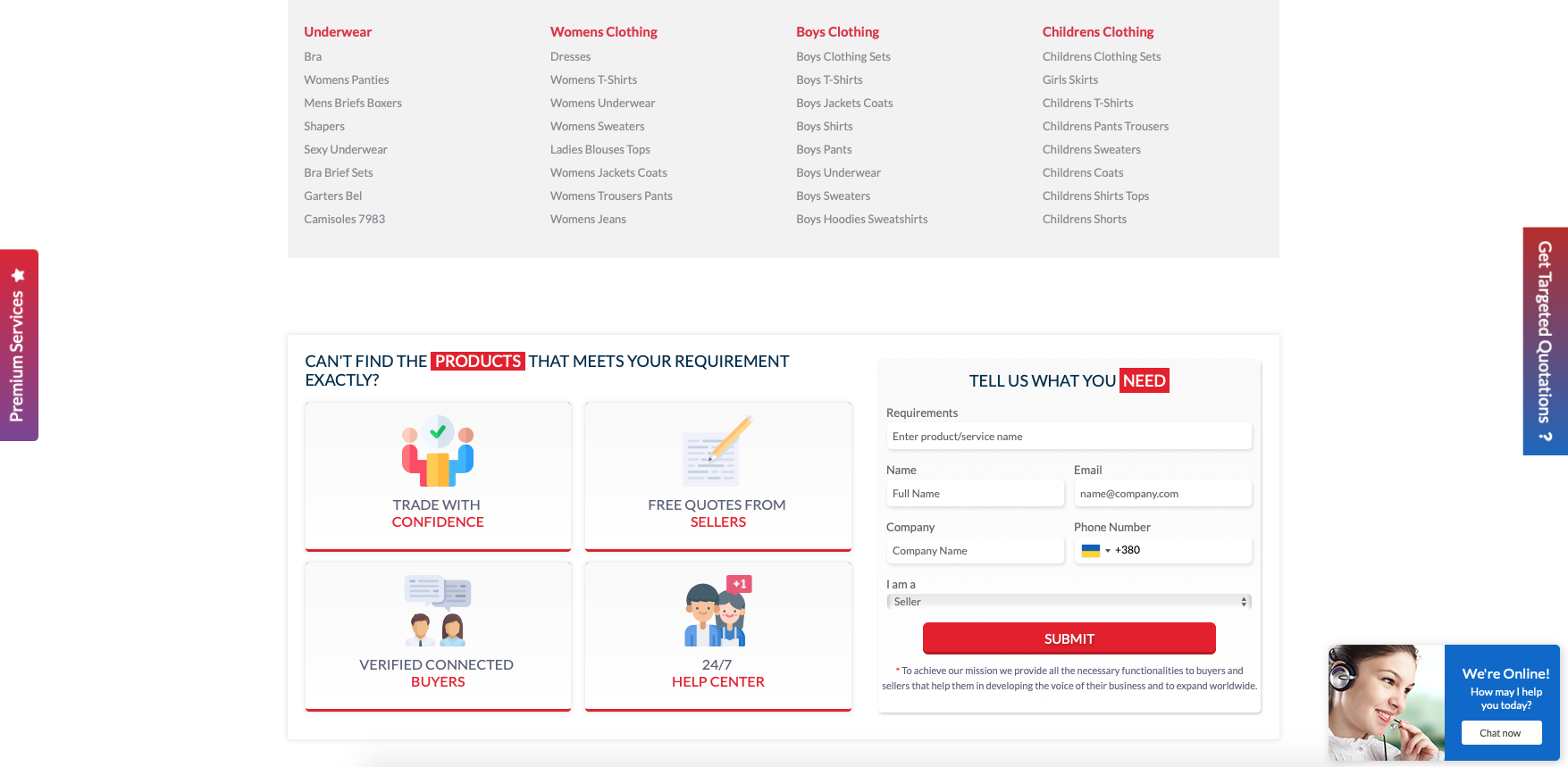-
Product Management
Software Testing
Technology Consulting
-
Multi-Vendor Marketplace
Online StoreCreate an online store with unique design and features at minimal cost using our MarketAge solutionCustom MarketplaceGet a unique, scalable, and cost-effective online marketplace with minimum time to marketTelemedicine SoftwareGet a cost-efficient, HIPAA-compliant telemedicine solution tailored to your facility's requirementsChat AppGet a customizable chat solution to connect users across multiple apps and platformsCustom Booking SystemImprove your business operations and expand to new markets with our appointment booking solutionVideo ConferencingAdjust our video conferencing solution for your business needsFor EnterpriseScale, automate, and improve business processes in your enterprise with our custom software solutionsFor StartupsTurn your startup ideas into viable, value-driven, and commercially successful software solutions -
-
- Case Studies
- Blog
Marketplace vs Ecommerce, or Why to Shift from Inventory to the Multi-vendor Marketplace Model
By 2024, the marketplace sector of ecommerce is set to exceed $7 trillion in sales. Online customers are lured by the broad array of choices on marketplaces while brands are keen to feature their products on multiple platforms. As a result, in the “marketplace vs ecommerce store” competition the former wins.
The ecommerce has seen a shift from the inventory to the multi-vendor marketplace model. The core reason behind this shift is the ambitions of platform owners to boost profits while reducing financial risks and cutting down on spending.
When discussing Ecommerce vs Marketplace, you need to understand all the pros and cons of both the inventory and marketplace models and explore how to smoothly transition from the former to the latter.
What’s the inventory model?
In the inventory model, a single ecommerce entity manages the marketplace and stores and dispatches merchandise. This entity can be a manufacturer offering its own products. Alternatively, this entity can purchase and stock goods from other brands, then sell them directly to customers. In the case of a supply shortage, an ecommerce entity obtains products directly from a seller or manufacturer.
The inventory model has some advantages. Marketplace owners can control stock levels as well as packing and shipping processes. This contributes to an excellent post-purchase customer experience, allowing the marketplace to deliver goods fast and accurately.
The problem is that being fully in control of merchandise means that companies compromise capital efficiency. Buying products from vendors up front means tying up money in stock and exposing oneself to markdown risk.
What’s a multi-vendor marketplace?
A multi-vendor marketplace acts as a meeting ground for sellers and buyers and is accountable for the selling and buying processes. Based on the type of the platform, it might or might not be in charge of various aspects of the post-purchase experience and customer service. In terms of how multi-vendor marketplaces operate, there are homogeneous and heterogeneous solutions. Let’s consider both.
Homogeneous marketplaces
If an ecommerce platform offers homogeneous supply, it means that one supplier’s goods or services are almost indistinguishable from another’s. Upon receiving an order, a homogenous marketplace passes it to a seller that fulfills it. For example, a customer using Uber doesn’t choose a specific driver – an algorithm finds the closest service provider. Simply put, this is a matching marketplace.

Heterogeneous marketplaces
A heterogeneous marketplace allows users to hunt for a particular product or service by themselves. This is a search-based marketplace – not a matching one – in which customers look for desired listings. This creates some cognitive load on the customer’s side, which can increase the drop-off rate. Reducing it becomes the main challenge for heterogeneous marketplaces.

Online Marketplace vs Ecommerce: Hybrid model
For those choosing to embrace the benefits of both the inventory and marketplace models, there’s the hybrid model. With this model, the marketplace offers vendors inventory storage, packaging, and delivery services. It is also in charge of pricing, returns management, and customer support.

Now that we’ve discussed Marketplace vs Ecommerce, let’s go through the benefits of transitioning to a multi-vendor model.
Why shift to a multi-vendor marketplace model?
All motives for transitioning to the multi-vendor marketplace model boil down to maximizing capital efficiency and improving customer satisfaction. Let’s have a look at each reason in detail to resolve the “ecommerce website vs marketplace” dilemma.
1. Cut expenses
Multi-vendor marketplaces don’t spend on inventory or delivery (unless they choose to), as sellers store and ship their own merchandise. This means there’s no need to rent or buy warehouses, track merchandise availability, deal with delivery issues, or handle other sales routines.
The principal investment of multi-vendor marketplaces is a web platform that facilitates communication between customers and vendors. However, there’s a way to cut down on spending when building this platform. You can begin with an MVP, test the primary features, and then proceed with development.
2. Increase revenue
Since multi-vendor marketplaces feature numerous vendors, they attract more customers. Providing they are convinced to make a purchase, the number of transactions increases, and so does the marketplace profit.
To streamline this process, however, marketplaces should avoid manually managing any routine tasks such as vendor onboarding or product delivery. Simplified algorithms and boundless automation will make selling and buying easy and smooth.
Moreover, switching to a multi-vendor model opens new possibilities for monetization, as discussed below.
3. Minimize risks
Multi-vendor marketplaces don’t buy any of the products sold on them. As they don’t have to provide storage either, inaccurate forecasting, theft, loss, and damage are not issues.
Any logistics hazards, such as the risk of loss or delayed delivery, are also not a concern because marketplaces are not engaged in delivery or packaging unless they choose the hybrid model. However, there are some risks that multi-vendor platforms still face, like fraud and security issues. It would be a great idea to offer buyers policies that protect them in such cases and ensure that reputational losses won’t occur. These may include policies like Amazon has to ensure sellers act honestly.
4. Boost brand awareness
As multi-vendor marketplaces partner with brands and more customers flock to their websites, brand awareness grows. A growing number of people learn about an ecommerce platform, becoming able to recall and recognize it much easier.
Ways of increasing brand awareness include using SEO techniques, partnering with other brands, and launching referral marketing campaigns.
5. Get more scalability options
A Feedvisor study suggests that consumers are prone to opt for large marketplaces over small ones because they’re more dependable and offer a better assortment of products. Multi-vendor marketplaces do tend to be larger than ecommerce stores, and customers are constantly flocking to them.
The more traction you get on your platform, the more chances you have to scale your business, which means increased profit and new opportunities. For example, with a marketplace, it’s more likely you’ll be able to go beyond geographical limits so you can start scaling and reach foreign customers.
6. Use more monetization options
When weighing up Marketplace vs Ecommerce, you need to remember that the multi-vendor model allows marketplaces to discover multiple ways of earning revenue. Commissions are a popular monetization method: a marketplace owner gets part of each payment made on the platform. Some multi-vendor marketplaces also use listing fees, charging vendors for each service or product advertised.
Premium listings are another common monetization approach for marketplaces. Premium listings are ranked at the top of search results so customers can see them with no effort. Ads and subscriptions are two other popular monetization options.

7. Attract investors
As the pandemic has accelerated the shift to ecommerce by more than five years, no doubt this sector will attract investors in 2021 and beyond. Multi-vendor marketplaces are especially appealing to investors because of their explosive growth and profitability.
Apart from recurring revenue, marketplaces are attractive as they address a variety of markets and benefit greatly from the network effect. They also enjoy visibility, as well-known platforms tend to constantly attract new market players.
Wrapping up
As you can see, there are many reasons for shifting to the multi-vendor model, the major one being increased profit. Online marketplaces are set to exceed $7 trillion in sales by 2024, and you could get your piece of that pie. However, to get the most out of your endeavor, it’s a good idea to consider a few points.
Things to consider before shifting to a multi-vendor marketplace model
By addressing the following points, you can speed up the shift from the inventory to the multi-vendor model, cut your expenses, and avoid common pitfalls on the way.
Migration challenges
Ecommerce website owners transitioning to the multi-vendor model should decide whether to use their old infrastructure or build a brand-new tool. Creating infrastructure from scratch might be challenging, but using a SaaS or white label solution can mitigate expenses and boost your transition speed. With smart importing, you can migrate data with minimal if any data loss.
Keeping user satisfaction high
As marketplaces start interacting with more sellers and customers, it can be challenging to render quality services and uphold one’s good name.
With security threats and fraud being pressing issues, it’s vital for marketplaces to establish comprehensive rules. General rules might cover basic marketing and intellectual property rights. Posting instructions will be helpful to specify enforcement actions if a vendor publishes incorrect product information. Rules for collecting payments are of the essence to ensure payment security, while trade and dispute rules will ensure logistics security.
Staying within budget
Transitioning to the multi-vendor model requires additional expenses, whether your marketplace is based on old infrastructure or built from scratch. The good thing is that you can begin with an MVP to start your marketplace, test its core features, and add more functionality later. Choose a multi-vendor solution to validate your business hypothesis with a reasonable investment.
Delivery and logistics management
There are two options to handle logistics and delivery when shifting to the multi-vendor model. The most common case is when each vendor delivers goods by themselves. Another option is when delivery is managed via a centralized warehouse – this is the hybrid model used by Amazon.
In any case, marketplaces should provide vendors and buyers with convenient delivery options while helping them manage costs and track shipments. Comprehensive delivery settings (delivery time, shipping rate, etc.) will help you in handling a variety of delivery methods.
To make the customer experience smooth, it’s best to embrace the services of various shipping carriers. Your choice may include USPS for the United States, DHL or DPD for Europe, and UPS or FedEx for worldwide delivery.
Conclusion
As consumers strive for greater choice and sellers want to be featured on numerous platforms, increasingly more ecommerce owners shift to the multi-vendor marketplace model.
It allows you to increase revenue, boost brand awareness, minimize risks, and attract investors. The challenges within this process, such as migration issues and maintaining user satisfaction, are manageable and shouldn’t impede the transition.
FAQ
-
Embracing a multi-vendor marketplace model helps you increase revenue, cut expenses, boost brand awareness, and attract investors.
-
Migration difficulties, keeping user satisfaction at a high level, and staying within budget are the main tasks you’ll need to solve.
-
Choose software solutions like MarketAge with a custom importing feature. With custom importing, migrating from any ecommerce platform will be hassle-free and can be accomplished with minimal data loss.
On the hunt for seasoned professionals to help you launch a multi-vendor marketplace? Contact RubyGarage and get an advanced marketplace on short notice.










